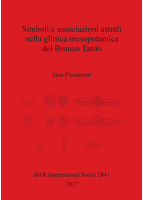Description
Il II millennio a.C. in Mesopotamia è caratterizzato da un incremento delle raffigurazioni astrali, le quali assumono un ruolo importante come rappresentazione non antropomorfa di divinità e specchio di osservazioni del cielo. Il presente volume presenta unanalisi dei simboli con valore astrale nella glittica mitannica, cassita e medio-assira. Partendo da unanalisi degli elementi simbolici presenti su un corpus di 1090 sigilli e impronte di sigillo, sono stati individuati e singolarmente analizzati, contestualmente alla loro posizione nella scena, i simboli con valore astrale. Inoltre, lo studio delle relazioni fra i simboli - astrali e non astrali - ha permesso lidentificazione di alcune associazioni ricorrenti. La loro comparazione con fonti testuali (es. omina e compendi astronomici) e con la ricostruzione del cielo mesopotamico del Bronzo Tardo, ha permesso la comprensione della percezione mitannica, cassita e medio-assira della volta celeste e del suo legame con il sentire religioso e la pratica divinatoria.In Mesopotamia of the 2nd millennium BC, astral representations spread throughout art, assuming an important role as the symbolic representation of deities and the mirror of real celestial observations. The present book focuses on astral symbols as they are represented on Mitannian, Cassite and Middle Assyrian seals and seal impressions. Starting from an analysis of the symbols on a corpus of 1090 seals and seal impressions, those with astral significance have been identified and individually analyzed, as has their position in the scene. Furthermore, a study of the relationship between the symbols - both astral and non-astral - allows for the identification of some recurring patterns. The comparison of the representations with textual sources (e.g. astral omina and astronomical compendia) and the reconstruction of the Mesopotamian sky in the Late Bronze Age Period yields an understanding of the Mitannian, Cassite and Middle Assyrian perception of the heavens and of its link with religious behaviour and divination.
AUTHOR
Sara Pizzimenti è Assegnista di Ricerca alla Sapienza Università di Roma. Membro di diverse missione archeologiche nel Vicino Oriente, come Tell Mardikh-Ebla (Siria), Karkemish (Turchia) e Zurghul-Nigin (Iraq), il suo lavoro spazia dalla glittica mesopotamica alla cultura materiale del Bronzo Tardo e delletà del Ferro del Levante settentrionale.Sara Pizzimenti is a Research Fellow in Near Eastern Archaeology at La Sapienza - University of Rome. She has participated in several archaeological expeditions in the Near East, including Tell Mardikh-Ebla (Syria), Karkemish (Turkey) and Zurghul-Nigin (Iraq), and the scope of her work ranges from Mesopotamian glyptics through Late Bronze Age material culture to Iron Age Northern Levant pottery assemblages.











